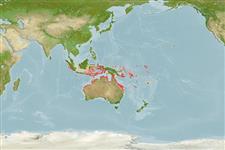Teleostei (teleosts) >
Ophidiiformes (Cusk eels) >
Dinematichthyidae (Viviparous brotula)
Etymology: Diancistrus: Greek, di = two + Greek, agkistron = hook (Ref. 45335); jeffjohnsoni: Named for Jeff Johnson of Queensland Museum, Brisbane.
Eponymy: Jeffrey W ‘Jeff ’ Johnson joined the Queensland Museum, Brisbane as a cadet (1977) and worked as assistant to the Curator of Fishes (1977–1995). [...] (Ref. 128868), visit book page.
More on authors: Schwarzhans, Møller & Nielsen.
Environment: milieu / climate zone / depth range / distribution range
Ecology
Marine; demersal; depth range 2 - 4 m (Ref. 57884). Tropical
Western Pacific: Western Australia to Queensland, Australia.
Size / Weight / Age
Maturity: Lm ? range ? - ? cm
Max length : 6.0 cm SL male/unsexed; (Ref. 57884); 7.9 cm SL (female)
Short description
Identification keys | Morphology | Morphometrics
Dorsal soft rays (total): 70 - 77; Anal soft rays: 55 - 63; Vertebrae: 42 - 44. This species is distinguished by the following: Vertebrae (11-) 12+ 30-32=42-44, dorsal fin rays 70-77, anal fin rays 55-63; eyes that are moderately large (2.4-3.0% SL), D/V 6-7; outer pseudoclasper large, twice the length of the inner pseudoclasper, wing-shaped, with narrow base, flat and its posterior part strongly bent backward; inner pseudoclasper almost completely joined to outer pseudoclasper anteriorly, thin, small, with single tip, not extending over anterior part of outer pseudoclasper; narrow scale patch on cheek with 3-5 scale rows on upper cheek, single large scale on operculum above opercular spine, usually covered by mucus and skin; head is slender, elongate (head depth 14-17% SL); first and second lower preopercular pore with separate opening (not fused as in all other species of the genus); otolith slender, length to height ratio 2.2-2.3, otolith length to sulcus length 2.2-2.4, dorsal rim regularly curved without angles (Ref. 57884).
Life cycle and mating behavior
Maturity | Reproduction | Spawning | Eggs | Fecundity | Larvae
Schwarzhans, W., P.R. Møller and J.G. Nielsen, 2005. Review of the Dinematichthyini (Teleostei, Bythitidae) of the Indo-West-Pacific. Part I. Diancistrus and two new genera with 26 new species. The Beagle, Records of the Museum and Art Galleries of the Northern Territory 21:73-163. (Ref. 57884)
IUCN Red List Status (Ref. 130435: Version 2024-2)
Threat to humans
Harmless
Human uses
Tools
Special reports
Download XML
Internet sources
Estimates based on models
Preferred temperature (Ref.
123201): 24.9 - 29.2, mean 28.2 °C (based on 751 cells).
Phylogenetic diversity index (Ref.
82804): PD
50 = 0.5000 [Uniqueness, from 0.5 = low to 2.0 = high].
Bayesian length-weight: a=0.00389 (0.00180 - 0.00842), b=3.12 (2.94 - 3.30), in cm total length, based on all LWR estimates for this body shape (Ref.
93245).
Trophic level (Ref.
69278): 3.3 ±0.5 se; based on size and trophs of closest relatives
Fishing Vulnerability (Ref.
59153): Low vulnerability (10 of 100).
